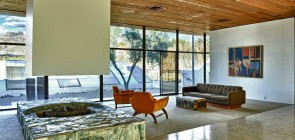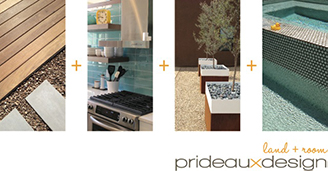In this climate of economizing, downsizing and tree-hugging, yes it does. Small is big, even in the expansive south-west. By Gillian Drummond. Cover photo by Chad Goebel.
At just 64 sq ft, Chad Goebel's guest studio isn't even big enough to be called a studio. So he calls it a pod.
It stands at the bottom of his yard in downtown Tucson, and was born of the patio doors from the main house. When Chad had the doors replaced, he eyed the old ones and started thinking. He looked at some plans in DIY magazines, pored over some ads in Dwell, then drew up his own, original plans for a guest pod. It helps that Chad's business is interior design; he works for his family's firm, Goebel Interiors.
The sliding patio doors dictated its width, as did local building guidelines that stipulate a structure under 120 square feet does not require a permit. He bought everything he could at Home Depot, he says, including the wood frame, the redwood fencing that forms the base, and the fiber cement HardieTrim Boards that acts as a fascia. He added horizontally placed sheets of corrugated aluminum for extra interest.
The interior is a lesson in not only space saving but thriftiness: an IKEA sofabed (price: $180); a rug bought on Overstock.com for $200 and cut to fit; IKEA shelving; a white table from Overstock.com; remnants of fabric from previous interior design jobs; a small air conditioning unit; and a metal stool found in a dumpster. He estimates that the whole guest pod cost just $2700.
Chad shares the main house with his writer partner, who works out of an upstairs loft. The guest pod was built as Chad's personal space - a place for him to read, work on the computer or nap. But it also serves as a guest bedroom for friends.
3 Story's Madeleine Boos is no stranger to making the most of small spaces, having lived and worked in a 550 square foot studio apartment in downtown Chicago. Set in a 1960s high-rise building, the unit had its original finishes: dark linoleum floor tiles, metal bi-fold closet doors, a small dark kitchen with minimal storage, and a vinyl accordion room divider.
Wanting an open, light and efficient plan, Madeleine took on the design and total gut renovation for about $40,000. Walls were removed and a clerestory window was added to the bathroom so all areas could receive natural light. By replacing an under-used coat closet with new cabinetry (and a place to conceal the refrigerator), the kitchen became open, spacious and extended into the living area.
"There are simple ways to make a space feel larger," says Madeleine. "Use one type of continuous flooring to create an expansive and unified feel. Tuck microwave ovens and other small appliances below the counter so your eye travels uninterrupted. Likewise, in the bathroom, place accessories and toiletries in drawers or up in a cubbie and medicine cabinet. A clear surface feels spacious and calming too."
Tucson interior designer Florencia Turco DeRoussel of Within Studio has worked on projects ranging from 60-plus acres to "the smallest of elevators". She has also worked on mobile homes. These not only have specific space requirements, they have their own weight requirements too, she says.
"We need to be careful in the floorings and counters that we choose, for example. These small homes need more storage, but they also need to have multi-function rooms. They need to be able to have larger dinner parties and movie nights. These same rooms need to transform into guest quarters and offices," says Florencia, whose small space tips include multi-functional furniture and clever use of mirrors (see below, It's not the size, it's what you do with it).
She adds: "What I am seeing now is people being smarter with their money and what they are choosing to invest in. My clients are purchasing better quality items and less quantity of items."
One company hoping to ride on the back of both of these trends - small space living and smarter buying - is Resource Furniture, a company that specializes in efficient use of space. Living small is getting huge, says Resource Furniture's President and co-founder Ron Barth. He puts it down to three things: migration to cities from the suburbs for jobs; a depressed economy in which homeowners are reluctant to move house; and the 'tree hugging' factor - the fact that consumers don't want to use or buy in excess.
Ron is seeing a demand for what he calls "micro-unit" living spaces, and the interest is from all over the country. Resource Furniture operates five showrooms in North America and Canada. The large amount of inquiries his company was getting from California led it to add a sixth, in Los Angeles, which opens this month.
"We get a higher percentage of customer inquiries from California than even New York, and these are from the Los Angeles area, not San Francisco," says Ron. He says the amount of mid-century houses and small-space living in beach communities in L.A. is driving that demand.
Among Resource Furniture's space-saving furniture pieces is the Cristallo, a coffee table with glass top and metal frame that adjusts to various heights, including dining, thanks to a hydraulic lift system and two self-storing leaves. Prices start at $3,025.
Its Lollisoft IN bunk beds, made in Italy by Clei, fold to only 12.25” deep but extend to 39” deep. The beds are the length of an extra-large twin, and their steel frames, beechwood slats and real mattresses mean they're designed for daily use. Prices start at $6,600.
Ron justifies his price points with an assurance that all of the products carry a lifetime warranty, and argues that someone renting a smaller space in the middle of a city will save on commuting time, and have less furniture to buy than they would living in the suburbs.
Resource Furniture's numbers speak for themselves: a website with 10,000 unique visitors a day; up to 300 emails a day; and YouTube videos demonstrating its products with more than seven million views.
Many of the company's space-saving furniture pieces are currently on display at a mock 325 sq ft apartment, part of an exhibition at the Museum of the City of New York showcasing design solutions for the city's changing demographics.
It's not the size, it's what you do with it
Florencia Turco DeRoussel of Within Studio offers these tips for small space living:
1. Invest in multi-purpose furniture. "Use a chair that pulls out into a twin sleeper, and learn to love ottomans. These guys can go under tables and in corners or at the foot of a bed. They transform into tables or hidden storage, and they're a great way to add seating without taking up space."
2. Invest in a cabinet builder/craftsman you like. "Pick one that you really like to build pieces that are scaled and custom-built for your space."
3. Be smart with your walls. "A room divider can be extremely helpful if used correctly. A wall can have storage on one side and wall space on another. It can help divide space without closing them off from each other, and can add drama and visual interest."
4. Curtains create magic. "Long curtains create drama but also can give the illusion of taller ceilings and larger windows. Use them to separate a room (instant guest quarters) or to hide much-needed storage."
5. Mirrors, mirrors and more mirrors. "They instantly add light and space. Strategically placed, they can double a room's apparent size. Place a plant in front of a mirror and you have a huge bouquet. Place a mirror opposite your window and now you have views on both sides of your home."
6. Use all of your home. "There are secret storage spaces wherever you look. There are lots of areas that you can use as storage if you really look. There are all kinds of furniture pieces that come with hidden storage compartments. Get them."
7. Purge and donate. "Most of us keep a lot of stuff and then have storage units for more stuff. We keep grandma's old chair because we think we may use it one day, or her favorite sweater. Why not a photograph of grandma in her chair? If it's not an antique, use some of the fabric or wood from the chair and make a picture frame. Be smart about what you store and the rest just donate. You will downsize your life and upsize your heart."
* Resource Furniture's new Los Angeles showroom, at 314 N. Crescent Heights Blvd, opens officially June 21. Visits are available by appointment only until then. Contact [email protected]





















